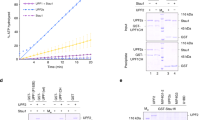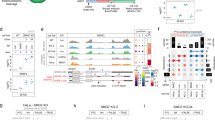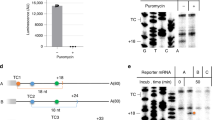Abstract
In mammalian cells, nonsense-mediated messenger RNA decay (NMD) targets newly synthesized nonsense-containing mRNA bound by the cap-binding-protein heterodimer CBP80-CBP20 and at least one exon-junction complex (EJC). An EJC includes the NMD factors Upf3 or Upf3X and Upf2, and Upf2 recruits Upf1. Once this pioneer translation initiation complex is remodeled so that CBP80-CBP20 is replaced by eukaryotic initiation factor 4E, the mRNA is no longer detectably targeted for NMD. Here, we provide evidence that CBP80 augments the efficiency of NMD but not of Staufen1 (Stau1)-mediated mRNA decay (SMD). SMD depends on the recruitment of Upf1 by the RNA-binding protein Stau1 but does not depend on the other Upf proteins. We find that CBP80 interacts with Upf1 and promotes the interaction of Upf1 with Upf2 but not with Stau1.
This is a preview of subscription content, access via your institution
Access options
Subscribe to this journal
Receive 12 print issues and online access
$189.00 per year
only $15.75 per issue
Buy this article
- Purchase on Springer Link
- Instant access to full article PDF
Prices may be subject to local taxes which are calculated during checkout








Similar content being viewed by others
References
Ishigaki, Y., Li, X., Serin, G. & Maquat, L.E. Evidence for a pioneer round of mRNA translation: mRNAs subject to nonsense-mediated decay in mammalian cells are bound by CBP80 and CBP20. Cell 106, 607–617 (2001).
Chiu, S.Y., Lejeune, F., Ranganathan, A.C. & Maquat, L.E. The pioneer translation initiation complex is functionally distinct from but structurally overlaps with the steady-state translation initiation complex. Genes Dev. 18, 745–754 (2004).
Lejeune, F., Ranganathan, A.C. & Maquat, L.E. eIF4G is required for the pioneer round of translation in mammalian cells. Nat. Struct. Mol. Biol. 11, 992–1000 (2004).
Lejeune, F., Ishigaki, Y., Li, X. & Maquat, L.E. The exon junction complex is detected on CBP80-bound but not eIF4E-bound mRNA in mammalian cells: dynamics of mRNP remodeling. EMBO J. 21, 3536–3545 (2002).
Lykke-Andersen, J., Shu, M.D. & Steitz, J.A. Communication of the position of exon-exon junctions to the mRNA surveillance machinery by the protein RNPS1. Science 293, 1836–1839 (2001).
Kim, Y.K., Furic, L., Desgroseillers, L. & Maquat, L.E. Mammalian Staufen1 recruits Upf1 to specific mRNA 3′UTRs so as to elicit mRNA decay. Cell 120, 195–208 (2005).
Gehring, N.H., Neu-Yilik, G., Schell, T., Hentze, M.W. & Kulozik, A.E. Y14 and hUpf3b form an NMD-activating complex. Mol. Cell 11, 939–949 (2003).
Kataoka, N. & Dreyfuss, G. A simple whole cell lysate system for in vitro splicing reveals a stepwise assembly of the exon-exon junction complex. J. Biol. Chem. 279, 7009–7013 (2004).
Hirose, T., Shu, M.D. & Steitz, J.A. Splicing of U12-type introns deposits an exon junction complex competent to induce nonsense-mediated mRNA decay. Proc. Natl. Acad. Sci. USA 101, 17976–17981 (2004).
Nagy, E. & Maquat, L.E. A rule for termination-codon position within intron-containing genes: when nonsense affects RNA abundance. Trends Biochem. Sci. 23, 198–199 (1998).
Maquat, L.E. Nonsense-mediated mRNA decay: splicing, translation and mRNP dynamics. Nat. Rev. Mol. Cell Biol. 5, 89–99 (2004).
Tange, T.O., Nott, A. & Moore, M.J. The ever-increasing complexities of the exon junction complex. Curr. Opin. Cell Biol. 16, 279–284 (2004).
Lykke-Andersen, J., Shu, M.D. & Steitz, J.A. Human Upf proteins target an mRNA for nonsense-mediated decay when bound downstream of a termination codon. Cell 103, 1121–1131 (2000).
Zhang, J., Sun, X., Qian, Y. & Maquat, L.E. Intron function in the nonsense-mediated decay of beta-globin mRNA: indications that pre-mRNA splicing in the nucleus can influence mRNA translation in the cytoplasm. RNA 4, 801–815 (1998).
Moriarty, P.M., Reddy, C.C. & Maquat, L.E. Selenium deficiency reduces the abundance of mRNA for Se-dependent glutathione peroxidase 1 by a UGA-dependent mechanism likely to be nonsense codon-mediated decay of cytoplasmic mRNA. Mol. Cell. Biol. 18, 2932–2939 (1998).
Belgrader, P. & Maquat, L.E. Nonsense but not missense mutations can decrease the abundance of nuclear mRNA for the mouse major urinary protein, while both types of mutations can facilitate exon skipping. Mol. Cell. Biol. 14, 6326–6336 (1994).
Lejbkowicz, F. et al. A fraction of the mRNA 5′ cap-binding protein, eukaryotic initiation factor 4E, localizes to the nucleus. Proc. Natl. Acad. Sci. USA 89, 9612–9616 (1992).
Dostie, J., Lejbkowicz, F. & Sonenberg, N. Nuclear eukaryotic initiation factor 4E (eIF4E) colocalizes with splicing factors in speckles. J. Cell Biol. 148, 239–247 (2000).
Haghighat, A., Mader, S., Pause, A. & Sonenberg, N. Repression of cap-dependent translation by 4E-binding protein 1: competition with p220 for binding to eukaryotic initiation factor-4E. EMBO J. 14, 5701–5709 (1995).
Mader, S., Lee, H., Pause, A. & Sonenberg, N. The translation initiation factor eIF-4E binds to a common motif shared by the translation factor eIF-4 gamma and the translational repressors 4E-binding proteins. Mol. Cell. Biol. 15, 4990–4997 (1995).
Marcotrigiano, J., Gingras, A.C., Sonenberg, N. & Burley, S.K. Cap-dependent translation initiation in eukaryotes is regulated by a molecular mimic of eIF4G. Mol. Cell 3, 707–716 (1999).
Gingras, A.C., Kennedy, S.G., O'Leary, M.A., Sonenberg, N. & Hay, N. 4E-BP1, a repressor of mRNA translation, is phosphorylated and inactivated by the Akt (PKB) signaling pathway. Genes Dev. 12, 502–513 (1998).
Pal, M., Ishigaki, Y., Nagy, E. & Maquat, L.E. Evidence that phosphorylation of human Upf1 protein varies with intracellular location and is mediated by a wortmannin-sensitive and rapamycin-sensitive PI 3-kinase-related kinase signaling pathway. RNA 7, 5–15 (2001).
Bhattacharya, A. et al. Characterization of the biochemical properties of the human Upf1 gene product that is involved in nonsense-mediated mRNA decay. RNA 6, 1226–1235 (2000).
Mazza, C., Ohno, M., Segref, A., Mattaj, I.W. & Cusack, S. Crystal structure of the human nuclear cap binding complex. Mol. Cell 8, 383–396 (2001).
Serin, G., Gersappe, A., Black, J.D., Aronoff, R. & Maquat, L.E. Identification and characterization of human orthologues to Saccharomyces cerevisiae Upf2 protein and Upf3 protein (Caenorhabditis elegans SMG-4). Mol. Cell. Biol. 21, 209–223 (2001).
Luo, M., Duchaine, T.F. & DesGroseillers, L. Molecular mapping of the determinants involved in human Staufen-ribosome association. Biochem. J. 365, 817–824 (2002).
Mendell, J.T., ap Rhys, C.M. & Dietz, H.C. Separable roles for rent1/hUpf1 in altered splicing and decay of nonsense transcripts. Science 298, 419–422 (2002).
Maquat, L.E. Nonsense-mediated mRNA decay in mammals. J. Cell Sci. 118, 1773–1776 (2005).
Dostie, J. & Dreyfuss, G. Translation is required to remove Y14 from mRNAs in the cytoplasm. Curr. Biol. 12, 1060–1067 (2002).
Gao, Q., Das, B., Sherman, F. & Maquat, L.E. Cap-binding protein 1-mediated and eukaryotic translation initiation factor 4E-mediated pioneer rounds of translation in yeast. Proc. Natl. Acad. Sci. USA 102, 4258–4263 (2005).
Castanotto, D., Li, H. & Rossi, J.J. Functional siRNA expression from transfected PCR products. RNA 8, 1454–1460 (2002).
Kadlec, J., Izaurralde, E. & Cusack, S. The structural basis for the interaction between nonsense-mediated mRNA decay factors UPF2 and UPF3. Nat. Struct. Mol. Biol. 11, 330–337 (2004).
Izaurralde, E. et al. A nuclear cap binding protein complex involved in pre-mRNA splicing. Cell 78, 657–668 (1994).
Wickham, L., Duchaine, T., Luo, M., Nabi, I.R. & DesGroseillers, L. Mammalian staufen is a double-stranded-RNA- and tubulin-binding protein which localizes to the rough endoplasmic reticulum. Mol. Cell. Biol. 19, 2220–2230 (1999).
Gingras, A.C., Svitkin, Y., Belsham, G.J., Pause, A. & Sonenberg, N. Activation of the translational suppressor 4E-BP1 following infection with encephalomyocarditis virus and poliovirus. Proc. Natl. Acad. Sci. USA 93, 5578–5583 (1996).
Berger, F.G. & Szoka, P. Biosynthesis of the major urinary proteins in mouse liver: a biochemical genetic study. Biochem. Genet. 19, 1261–1273 (1981).
Lejeune, F., Li, X. & Maquat, L.E. Nonsense-mediated mRNA decay in mammalian cells involves decapping, deadenylating, and exonucleolytic activities. Mol. Cell 12, 675–687 (2003).
Acknowledgements
We thank E. Wolcott for technical assistance; members of the Maquat lab, especially H. Kuzmiak, for comments on the manuscript; E. Izaurralde (European Molecular Biology Laboratory, Heidelberg, Germany) for anti-CBP80; L. DesGroseillers (Université de Montreal, Montreal) for anti-Stau1; H. Baumann and B. Held (Roswell Park Cancer Institute, Buffalo, New York, USA) for anti-MUP; J. Lykke-Andersen (University of Colorado, Boulder, Colorado, USA) for anti-Upf1 and pcNMS2-UPF plasmids; N. Sonenberg (McGill Cancer Center, Montreal) for pACTAG2-HA3, pACTAG2-HA3-4E-BP1, pACTAG2-heIF4E and anti-4E-BP1; S. Morley (University of Sussex, Falmer, Brighton, UK) for pBS-Hs-CBP80 and pRSET-Hs-CBP80; J. Lewis (Anadys Pharmaceuticals, Inc., UK) for pRSET-Hs-CBP20; and F. LeRoy and S. Peltz (University of Medicine and Dentistry of New Jersey, Pistcataway, New Jersey, USA) for the FLAG-Upf1 baculovirus expression vector. This work was supported by US National Institutes of Health grant GM059614 to L.E.M.
Author information
Authors and Affiliations
Corresponding author
Ethics declarations
Competing interests
The authors declare no competing financial interests.
Supplementary information
Supplementary Fig. 1
SMD targets eIF4E-bound mRNA. (PDF 123 kb)
Supplementary Fig. 2
4E-BP1 inhibits the reduction in FLuc-MS2bs mRNA abundance that is mediated by tethering either MS2-Upf1 or MS2-HA-Stau1. (PDF 129 kb)
Supplementary Fig. 3
Tethering CBP80 or CBP20 downstream of a termination codon triggers NMD. (PDF 5272 kb)
Rights and permissions
About this article
Cite this article
Hosoda, N., Kim, Y., Lejeune, F. et al. CBP80 promotes interaction of Upf1 with Upf2 during nonsense-mediated mRNA decay in mammalian cells. Nat Struct Mol Biol 12, 893–901 (2005). https://doi.org/10.1038/nsmb995
Received:
Accepted:
Published:
Issue Date:
DOI: https://doi.org/10.1038/nsmb995
This article is cited by
-
FMRP-mediated spatial regulation of physiologic NMD targets in neuronal cells
Genome Biology (2024)
-
Nonsense-mediated mRNA decay pathway in plants under stress: general gene regulatory mechanism and advances
Planta (2024)
-
Loss of the fragile X syndrome protein FMRP results in misregulation of nonsense-mediated mRNA decay
Nature Cell Biology (2021)
-
Quality and quantity control of gene expression by nonsense-mediated mRNA decay
Nature Reviews Molecular Cell Biology (2019)
-
Identification of lncRNA MEG3 Binding Protein Using MS2-Tagged RNA Affinity Purification and Mass Spectrometry
Applied Biochemistry and Biotechnology (2015)



